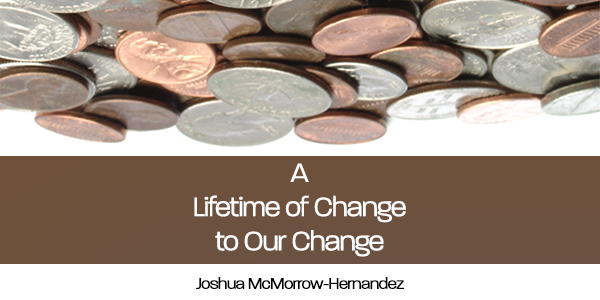
By Joshua McMorrow-Hernandez for CoinWeek …..
Look at the change in your pocket or purse. You’ll notice the coins in circulation look a lot different today than, say, in the mid-1990s. As recently as 1998, the array of current-production circulating coins included the Lincoln Memorial cent, the Jefferson nickel with traditional side-profile obverse bust, the Roosevelt dime and the Washington quarter with heraldic eagle.
Even the Kennedy half dollar, a coin that made only very occasional appearances in daily transactions during the 1990s, was still struck for circulation (the government stopped making halves for circulation in 2002). Meanwhile, thousands of United States Postal Service stamp vending machines, big-city transit authority token booths, laundromats and other establishments in the ’90s dispensed Susan B. Anthony dollars from the late ’70s and early ’80s as change.
And if you’re like me, this period in our nation’s coinage still holds a special place in your collecting memories.
So in that spirit, here’s a look at the last-year issues of several modern coin designs that collectors – and the American public – came to know well:
2008 Lincoln Memorial Cent
The end of the Lincoln Memorial cent in 2008 marked one of the biggest changes for the one-cent coin in a generation. Yet it seems change doesn’t come easy when it comes to the penny, a coin whose very future as a denomination has been cloudy for years.
Somehow, the American one-cent coin ticks on even as other major nations scrap their low-denomination coins amidst inflation and rising metal prices. It’s reasonable to believe that many Americans in the 1990s and the first years of the 21st century thought that the only change coming for the Lincoln cent would be its demise. For years, politicians and figures in the general public had been calling for an end to our lowest-denomination coin as a cost-cutting measure.
 But the Lincoln cent’s long-term existence was secured for perhaps several years when a series of design changes hit the coin’s reverse beginning in 2009. The four-installment Lincoln Bicentennial series, released over the course of 2009, profiles various chapters in Lincoln’s life. These include his birthplace, his formative years, Lincoln’s professional life and presidency. Following the last of the four Lincoln Bicentennial coins, the Lincoln cent reverse received a permanent redesign in 2010 with the Union Shield motif, designed by Lyndall Bass and sculpted by Joseph Menna (View Designer’s Profile).
But the Lincoln cent’s long-term existence was secured for perhaps several years when a series of design changes hit the coin’s reverse beginning in 2009. The four-installment Lincoln Bicentennial series, released over the course of 2009, profiles various chapters in Lincoln’s life. These include his birthplace, his formative years, Lincoln’s professional life and presidency. Following the last of the four Lincoln Bicentennial coins, the Lincoln cent reverse received a permanent redesign in 2010 with the Union Shield motif, designed by Lyndall Bass and sculpted by Joseph Menna (View Designer’s Profile).
Occasional motions to eradicate or alter the metallic composition of the cent come and go through Congress. One of the more recent bills, sponsored by former Ohio Democratic Congressman Zack Space (D-OH18), would have changed the metallic compositions of the one-cent coin and the five-cent nickel (which presently cost 1.7 cents and about 8 cents, respectively, to produce per coin) to a much cheaper steel composition. Despite the fact that the change would have saved taxpayers an estimated $100 million per year, the bill, which passed in the House, never became law. Concerns were raised by former U.S. Mint Director Edmund C. Moy, who suggested that the bill’s requirement that a new composition for the penny be chosen within 270 days of the law passing was “too prescriptive”.
And so the penny carries on.
Maybe it’ll stick around long enough for another potential reverse design change in 2059 to mark Lincoln’s 250th birthday, but meanwhile the common 2008 Lincoln Memorial cent remains plentiful and affordable. More than 2.55 billion business-strike examples were made at the Philadelphia Mint that year, and Denver churned out almost 2.85 billion. Almost every one of those coins, featuring the last run of Frank Gasparro’s Lincoln Memorial design, can be obtained in Gem Mint State grades for less than $1. San Francisco-minted Proof specimens are also abundant and can be bought for under $5.
2003 Jefferson Nickel Obverse and Reverse
As any longtime hobbyist will remember, in the 1990s the Jefferson nickel was considered one of the most numismatically lethargic series among all U.S. coins. Not only was the Jefferson nickel series a sleeper in terms of overall marketplace activity, but it had also seen relatively little modification over the previous five decades, save for the placement of designer Felix Schlag’s initials under the bust on the obverse of the coin in 1966 and some minor design enhancements during the ’70s and early ’80s.
The series received a proverbial B-12 injection in 2004 when the Westward Journey series launched, celebrating the bicentennial of the Lewis and Clark Expedition and their Corps of Discovery in 2004. The last Jefferson nickels featuring both its original side-profile bust of President Thomas Jefferson and an elevation view of Jefferson’s Virginia home Monticello were released in 2003.
There was relatively little fanfare surrounding the last original Jefferson nickels in 2003 – most of the numismatic buzz was focused on the new Westward Journey nickels to be released over the following two years.
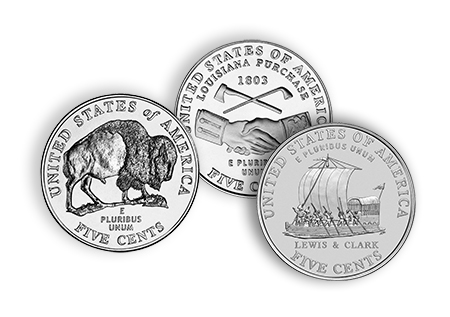 The traditional side profile of Jefferson remained on the 2004 nickel, with Peace Medal and Keelboat commemorative designs appearing on the reverse. In 2005, the nickel boasted a one-year-only obverse portrait inspired by a 1789 marble bust by artist Jean-Antoine Houdon; the 2005 obverse portrait, designed by Joe Fitzgerald and sculpted by Don Everhart (View Designer’s Profile) shows a rightward-facing portrait of Jefferson’s face, suggesting a hopeful gaze toward the future.
The traditional side profile of Jefferson remained on the 2004 nickel, with Peace Medal and Keelboat commemorative designs appearing on the reverse. In 2005, the nickel boasted a one-year-only obverse portrait inspired by a 1789 marble bust by artist Jean-Antoine Houdon; the 2005 obverse portrait, designed by Joe Fitzgerald and sculpted by Don Everhart (View Designer’s Profile) shows a rightward-facing portrait of Jefferson’s face, suggesting a hopeful gaze toward the future.
The reverses of the 2005 nickels portray the American bison and the rocky shoreline of the Pacific Ocean. The latter of the two 2005 nickels celebrates the jubilant occasion when the Lewis and Clark Expedition reached its final destination at the mouth of the Columbia River on the modern-day border of Oregon and Washington on November 7, 1805.
In 2006, a third obverse portrait of Jefferson was unveiled. The current portrait, designed by Jamie Franki and sculpted by Donna Weaver, shows a rightward-positioned Jefferson facing the viewer at three-quarters angle. On the reverse is a restored image of Monticello. The Jefferson nickels minted since 2006 are, quite aptly, still referred to as Jefferson nickels, though numismatic purists are inclined to categorize the newer Jefferson nickels as their own type. Several numismatic guidebooks reflect this sentiment, with the widely read A Guide Book of United States Coins (R.S. Yeoman and Kenneth Bressett, Whitman Publishing) referring to the nickels since 2006 as “Jefferson Modified, 2006-Date). Some regard the Jefferson nickels minted since 2006 merely as a subtype.
Those collecting 2003 Jefferson nickels will have little difficulty finding them. The Philadelphia Mint turned out 441,840,000 specimens while the Denver Mint produced 383,040,000, with each obtainable for less than $1 in Gem Mint State grades. Proof specimens from the San Francisco Mint can be purchased for $3.
1998 Washington Quarter with Heraldic Eagle
The Washington quarter is our nation’s second-oldest currently circulating coin, behind only the Lincoln cent. And like its smaller one-cent cousin, the Washington quarter has also undergone a major facelift in recent years. The 50 States Commemorative Coin Act was signed into law on December 1, 1997, paving the way for the 50 States Quarters program that launched on January 4, 1999 with the release of the Delaware quarter.
The Washington quarter and its Heraldic Eagle was designed by John Flanagan (View Designer’s Profile), who incorporated Art Deco influences in the creation of both the coin’s heraldic eagle and the inscription surrounding the central devices on the coin. The Washington quarter was released in 1932 and saw little change over the years. Prior to 1999, the two most significant events in the life of the Washington quarter were the switch from 90 percent silver to copper-nickel clad in 1965 and the American Bicentennial reverse design by Jack Ahr produced in 1975 and ’76.
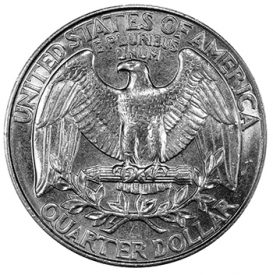 The Heraldic Eagle was restored in 1977 and lasted another 21 years, for an (almost) uninterrupted production run of 66 years.
The Heraldic Eagle was restored in 1977 and lasted another 21 years, for an (almost) uninterrupted production run of 66 years.
The commencement of the 50 States Quarters program in 1999 brought an end to the eagle reverse. Additionally, Flanagan’s bust of Washington was modified to accommodate the legends UNITED STATES OF AMERICA and QUARTER DOLLAR on the obverse (the date was moved to the reverse). It is therefore smaller than the original Flanagan design but it also features enhancements to Washington’s hair and other details. Mint sculptor-engraver William Cousins is responsible for the revisions.
Those who wish to buy examples of the 1998 Washington quarter can do so without much of a challenge. The Philadelphia Mint struck 896,268,000 and the Denver Mint produced 821,000,000. Gem Uncirculated specimens of either mint mark can be bought for approximately $6 each, while copper-nickel clad and 90-percent silver Proof specimens are usually obtainable for $5 and $8, respectively.
Some numismatists may wonder if the Heraldic Eagle will return to the quarter following the close of the America the Beautiful series in 2021 or later. According to the America’s Beautiful National Parks Quarter Dollar Act (Public Law 110-456), which authorizes the production of our current quarter dollar program, after the end of the America the Beautiful series, the quarter’s reverse “shall contain an image of General Washington crossing the Delaware River prior to the Battle of Trenton”. In other words, barring a change in law, the Washington quarter’s original Heraldic Eagle reverse has flown to that great coin collection in the sky.
2008 Sacagawea Dollar
The Sacagawea dollar was one of the most widely anticipated coins in a generation. Its release in 2000 was supposed to remedy the issues that helped cause the demise of the Susan B. Anthony dollar in 1981. Many complained the Susan B. Anthony dollar, also referred to as the “Carter Quarter” (the coin was released during President Jimmy Carter’s presidency, which lasted from 1977 until 1981), looked and felt too similar to the quarter-dollar coin. While the “Susie B.” briefly returned in 1999, it was only to help meet demand for a circulating dollar coin at a time when some vending operations utilized dollar coins in change before the Sacagawea dollar could be legally produced in 2000.
The Sacagawea coin appears significantly different than other U.S. coinage, thanks to its golden color, smooth edges and distinctive obverse and reverse designs. Still, the Sacagawea dollar failed to catch on with the public as a circulating coin. The main reason the coin did not circulate well was the concurrent continuance of the one-dollar bill, which, according to many public opinion polls, Americans preferred and still prefer by significant margins over dollar coins.
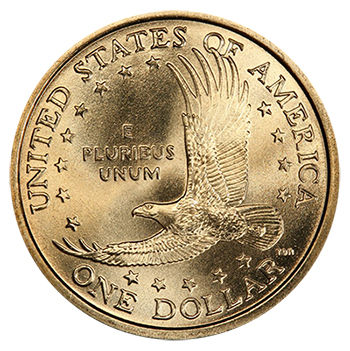 As the number of unused Sacagawea dollars stacked up in bank vaults, government officials realized the coin was not performing nearly as well as was originally hoped. By 2002, mintages of the Sacagawea dollar dropped to less than five million each for the Philadelphia and Denver Mints – enough to satisfy numismatic demand but not nearly enough for everyday commerce had the coin been circulating to the extent that had been expected. With the start of the Presidential $1 coin series in 2007 came the passage of the Native American $1 coin series, which honors Native Americans and important contributions to United States history made by Native American tribes and individuals. The Native American $1 series began in 2009, replacing the Sacagawea dollar.
As the number of unused Sacagawea dollars stacked up in bank vaults, government officials realized the coin was not performing nearly as well as was originally hoped. By 2002, mintages of the Sacagawea dollar dropped to less than five million each for the Philadelphia and Denver Mints – enough to satisfy numismatic demand but not nearly enough for everyday commerce had the coin been circulating to the extent that had been expected. With the start of the Presidential $1 coin series in 2007 came the passage of the Native American $1 coin series, which honors Native Americans and important contributions to United States history made by Native American tribes and individuals. The Native American $1 series began in 2009, replacing the Sacagawea dollar.
This makes the 2008 Sacagawea dollar the last in its series, though it was not the last dollar coin to feature an obverse design of the young Native American Shoshone woman and her infant child, Jean Baptiste. The Native American dollar, which showcases a new reverse design each year, contains the same obverse profile of Sacagawea carrying Jean Baptise in a papoose. However, the Native American dollar coins contain edge lettering with inscriptions once seen on the obverse and reverse of the Sacagawea dollar; these include the coin’s date and mintmark, and the Latin phrase E PLURIBUS UNUM.
Collectors who wish to purchase examples of the 2008 Sacagawea dollar can do so for relatively little money. The Philadelphia and Denver Mints each produced only 1,820,000 specimens for collector sets. These 2008-P and 2008-D Sacagawea dollars can be bought for less than $5 each. The S-Mint Proof sells for around $10.
Hub and Die Modifications
Perhaps the 1990s may seem an era quaint to U.S. coin collectors now, but it was a relatively frustrating period for many hobbyists who grew tired of staid coin designs – designs that had remained largely unchanged since the ’50s and ’60s. Some collectors were so bored with U.S. coinage that even hub changes were cause for excitement in the numismatic world. Several major and minor design modifications throughout the ’90s kept collectors checking their change for stronger hairlines and other details on the nation’s circulating coinage.
These modifications include a sharper beard on the Lincoln cent in the early 1990s. The Jefferson nickel also received notable enhancements in the early ’90s, with sharper detailing in the hair near Jefferson’s ear on the obverse and six fully formed steps on the reverse–though the coin featured a lower relief, overall. The Roosevelt dime, meanwhile, saw sharpening in Roosevelt’s hairlines on the obverse and lettering enhancements on the reverse.
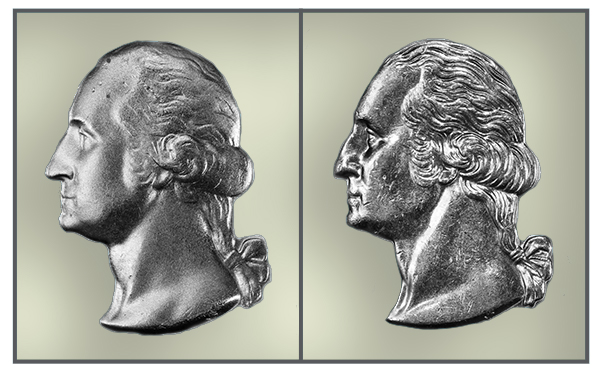
(Left) Washington quarter obverse in 1968. (Right) Obverse in 1998.
Perhaps the most controversial design change of the 1990s came to the quarter. No, not the 50 States Quarters program in 1999… I’m talking about major alterations to Washington’s hair in 1995. That is when officials at the U.S. Mint implemented the so-called “spaghetti hair” modification, altering the gently sculpted appearance of Washington’s hair with strongly enhanced hairlines. Some of the new hairlines (including the heaviest) were never present even on the most sharply struck of the early Washington quarters, causing some numismatists to decry the 1995 design enhancements as nothing more than meddling with what many thought was already a good thing.
As some collectors would suggest, the Mint has a history of going a little heavy on the hairlines every now and then. The late First Lady Jacqueline Kennedy once rebuffed the Mint over a similar matter when she felt the hairlines on early Proof 1964 Kennedy half dollars honoring her murdered husband, President John F. Kennedy, were too prominent. Though the Kennedy half dollar received small die modifications over the next few decades, a significant change in 1995 would have probably left Mrs. Kennedy, who had died one year earlier, reeling. The hair details on the Kennedy half dollar were given a “noodle-like” treatment similar to the accentuated hairlines seen on the 1995 Washington quarter.
Across the board, design reliefs were lowered during the 1990s to accommodate faster, more efficient minting and increase die life. While that does mean that more coins were made faster and for less money, modern low-relief coins don’t sit well in the minds and hearts of some collectors. Compared to the coins of the ’60s, ’70s and early ’80s, the circulating coinage of the ’90s looks flat, the devices and lettering appearing to only barely stand apart from their fields.
U.S. coinage has certainly seen a multitude of changes over the past several years. “Last year’s model” coins such as the 2008 Lincoln Memorial cent, the 2003 Jefferson nickel, the 1998 Washington quarter and the 2008 Sacagawea dollar make terrific additions to any modern U.S. coin collection. These are coins that may gain wider prominence as collectibles in the years ahead as more hobbyists realize the symbolic importance of these coins, not just in the numismatic arena but in the larger American culture.
* * *
Sources
http://latimesblogs.latimes.com/washington/2008/05/coinpolitics.html
http://blogs.wsj.com/economics/2014/12/15/just-how-much-does-it-cost-to-make-a-penny/
http://query.nytimes.com/gst/fullpage.html?res=9806E0D9103FF93AA35756C0A96E9C8B63
http://www.pcgscoinfacts.com/Coin/Detail/394897
http://www.pcgscoinfacts.com/Coin/Detail/394903
http://www.pcgscoinfacts.com/Coin/Detail/4152
http://www.pcgscoinfacts.com/Coin/Detail/4153
https://www.congress.gov/bill/105th-congress/house-bill/2414/text
http://www.pcgscoinfacts.com/Coin/Detail/5942
http://www.pcgscoinfacts.com/Coin/Detail/5943
https://www.congress.gov/bill/110th-congress/house-bill/6184/text
http://www.huffingtonpost.com/2011/10/19/majority-americans-dollar-bill-coin_n_1019704.html
http://www.foxnews.com/story/2007/02/12/poll-americans-dont-want-dollar-coins.html
http://www.pcgscoinfacts.com/Coin/Detail/394943
http://www.pcgscoinfacts.com/Coin/Detail/394945
http://kennedyhalfdollars.net/1964-accented-hair-variety-kennedy-half-dollar/
https://www.ngccoin.com/news/article/3965/USA-Coin-Album-Our-Shrinking-Coins/
PCGS-Graded U.S. Coins Currently Available on eBay
[wpebayads]




